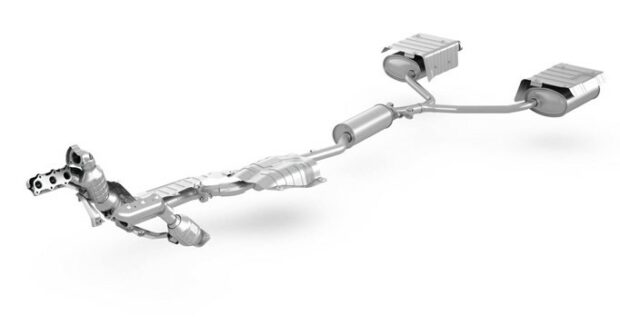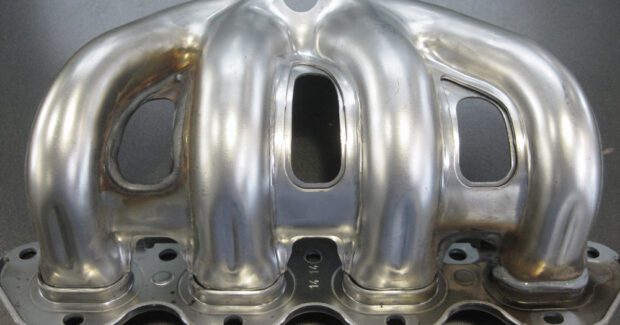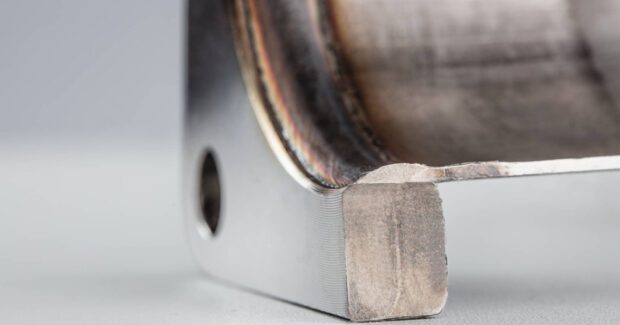Revolutionizing the Robotic Welding of Exhaust Components
Advanced process controls for automated MAG welding from Fronius consistently weld complex exhaust components by using high-performance electronics of power sources to adapt the arc in a controlled manner for optimum results.
Posted: November 29, 2019
Though electric vehicles are becoming increasingly popular, analysts predict that by 2025 more than two-thirds of all vehicles sold will still be powered exclusively by combustion engines – which is reason enough to consider how best to weld the exhaust systems that are used to draw combustion gases from the engine and clean them. Automated metal active gas welding (MAG) is most often used to join the individual exhaust components, which must withstand both high temperatures and corrosion demands that determine which material they should be made from. The exhaust manifold is particularly challenging to weld: its tight component radii force the robot to reduce the welding speed, yet the amount of energy directed into the component must be kept to a minimum and the welding process must remain stable and reproducible. The type and thickness of the material used is based on the demands and challenges placed on the other corresponding components. This requires the welding arc to be adapted to suit the respective components.
Different process control variants for automated MAG welding from Fronius USA LLC (Portage, IN) make it possible to consistently weld complex exhaust components. The high-performance electronics of modern power sources allow users to adapt the arc in a controlled manner and therefore achieve optimum results. For example, the Low Spatter Control (LSC) mode is based on a dip transfer arc and is both energy efficient and spatter-free. This is achieved by the welding system precisely controlling the short circuit: The power source accurately detects the wire electrode approaching the weld pool and regulates the detachment of the droplet into the weld pool in such a way that it happens at a lower power. This means that the heat input into the component is low and almost no spatter is created – ideal for joining components with small wall thicknesses and variable joint geometries such as those on exhaust manifolds. LSC also ensures high stability during the difficult reorientation of the welding torch and therefore high welding speeds.
Pulse Multi Control (PMC) is a modified pulsed arc characterized by precisely regulated and low-spatter droplet detachment. PMC creates a powerful, stable arc that offers high deposition rates and good controllability of the weld pool at the same time during out-of-position welding, for example. This means users can avoid imperfections such as undercuts and weld in a stable, reproducible manner. PMC is particularly well suited to components that are subject to tolerances and have severe variations in wall thickness – conditions that apply to a number of exhaust components. Even in these situations, PMC ensures sufficient penetration and a gap-bridging ability. Automotive suppliers regularly use this process to weld exhaust manifolds. In practice, it enables the use of considerably higher welding speeds to increase productivity.
The challenges the automotive industry may face in the future could shift the focus onto other process variables. One significant trend is the development of increasingly lightweight vehicles that reduce fuel consumption and use less material to reduce manufacturing costs. This affects the design of exhaust components. The temperature-resistant parent materials and filler metals used for welding allow the components to be manufactured from increasingly thinner materials, meaning components with wall thicknesses of 0.8 mm could become standard in the future. The CMT (Cold Metal Transfer) process is often used for this type of application. It combines a regulated dip transfer arc with a wire electrode that moves forwards and backwards. The result is a particularly low heat input and an incredibly stable welding process that allows users to achieve optimal results when welding very thin components.
Fronius USA LLC, 6797 Fronius Drive, Portage, IN 46368, 219-734 5701, [email protected], www.fronius.com/en/welding-technology.


















